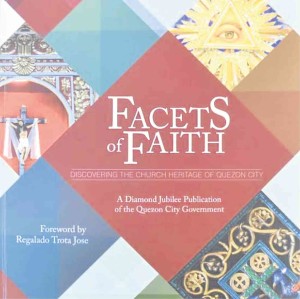
A product of the Cultural Heritage Studies (CHS) program of University of Santo Tomas Graduate School (USTGS), “Facets of Faith: Discovering the Church Heritage of Quezon City” (2016) is published by the Quezon City government in connection with the 75th anniversary of the city in 2014.
The book features 75 important ecumenical church properties in the city, including less-known sites such as the Spanish-era church of Krus na Ligas and the Andres Luna de San Pedro-designed Congregation of the Immaculate Heart of Mary provincial house on 14th Street in New Manila.
The book is authored by Billy Ray Malacura of the USTGS-CHS with photos from Inquirer sports photographer and Inquirer Lifestyle contributor Sherwin Vardeleon.
Foreword is by Church historian Regalado Trota José, who underscored the archaeological importance of the city, particularly Novaliches, which he described as one of the earliest sacred sites in Quezon City, or even Metro Manila, as evidenced by burial pots unearthed during the construction of La Mesa Dam in the 1920s.
“Facets,” perhaps one of the first books to feature interfaith church heritage, presents previously unknown aspects of Quezon City’s dynamic religious community. It is the center of various religious groups such as Iglesia ni Cristo and Church of Jesus Christ of Latter-Day Saints.
Quezon City is also the transfer site of important churches of Intramuros, Manila after World War II, such as Our Lady of Lourdes of the Franciscans and Santo Domingo Church and National Shrine of La Naval de Manila of the Dominicans.
The Santo Domingo Church complex, designed by National Artist for Architecture Jose Ma. Zaragoza, with its liturgical artworks, some of them by National Artist for the Visual Arts Carlos “Botong” Francisco, has been declared a National Cultural Treasure by the National Museum.
San Pedro Bautista Church of the Franciscans is also in Quezon City. It dates back to the 17th century and is now the headquarters of the Philippine Province of the Order of Friar Minors.
The Cathedral of St. Mary and St. John of the Episcopal Church of the Philippines also transferred to Quezon City following the destruction of the older church at Isaac Peral Street (now United Nations Avenue) during the war.
Works of National Artists can be found in religious buildings in Quezon City such as
St. Joseph Adoration Chapel on Hemady Avenue, by Zaragoza; Church of the Holy Sacrifice in University of the Philippines (UP) Diliman, by National Artist for Architecture Leandro Locsin. The UP chapel has the Stations of the Cross of National Artists for the Visual Arts Vicente Manansala and Ang Kiukok.
This book, worthy to be emulated by other towns and cities, is a testament to the religious and cultural heritage not only of Quezon City but of the country in general.
The book promotes diversity, peace and respect through dialogue between cultures and religions, emphasizing faith as a common ground. —CONTRIBUTED